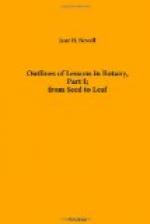These lessons on seeds are suitable for pupils of every age, from adults to the youngest children who go to school. The difference should be only in the mode of treatment; but the same principles should be brought out, whatever the age and power of comprehension of the pupil.
For these lessons the following seeds should be planted, according to the above directions:
Morning-Glory, Sunflower or Squash, Bean, Pea, Red Clover, Flax, Corn, Wheat, and Oats.[1] If they can be procured plant also acorns, Pine-seeds, Maple-seeds, and horsechestnuts.
[Footnote 1: A package of these seeds may be obtained for fifty cents, from Joseph Breck & Son, Boston, Mass. They will be sent by mail, postage paid.]
2. Study of Morning-Glory, Sunflower, Bean, and Pea.—For reasons hereafter given, I consider the Morning-Glory the best seedling to begin upon. Having a series, as above described, before them, the pupils should draw the seedlings. When the drawings are made, let them letter alike the corresponding parts, beginning with the plantlet in the seed, and using new letters when a new part is developed. The seed coats need not be lettered, as they do not belong to the plantlet.
[Illustration: FIG. 5.—Germination of Morning Glory, a, caulicle; b, cotyledons; c, plumule; d, roots.]
[Illustration: FIG. 6.—Germination of Sunflower.]
After drawing the Morning-Glory series, let them draw the Sunflower or Squash in the same way, then the Bean, and finally the Pea. Let them write answers to the following questions:
MORNING-GLORY.[1]
[Footnote 1: It has been objected that the Morning-Glory seed is too small to begin upon. If the teacher prefer, he may begin with the Squash, Bean, and Pea. The questions will require but little alteration, and he can take up the Morning-Glory later.]
Tell the parts of the Morning-Glory seed.
What part grows first?
What becomes of the seed-covering?
What appears between the first pair of leaves?
Was this to be seen in the seed?
How many leaves are there at each joint of stem after the first pair?
How do they differ from the first pair?
SUNFLOWER OR SQUASH.
What are the parts of the seed?
What is there in the Morning-Glory seed that this has not?
How do the first leaves change as the seedling grows?
BEAN.
What are the parts of the seed?
How does this differ from the Morning-Glory seed?
How from the Sunflower seed?
How do the first pair of leaves of the Bean change as they grow?
How many leaves are there at each joint of stem?[1]
[Footnote 1: There are two simple leaves at the next node to the cotyledons; after these there is one compound leaf at each node.]




